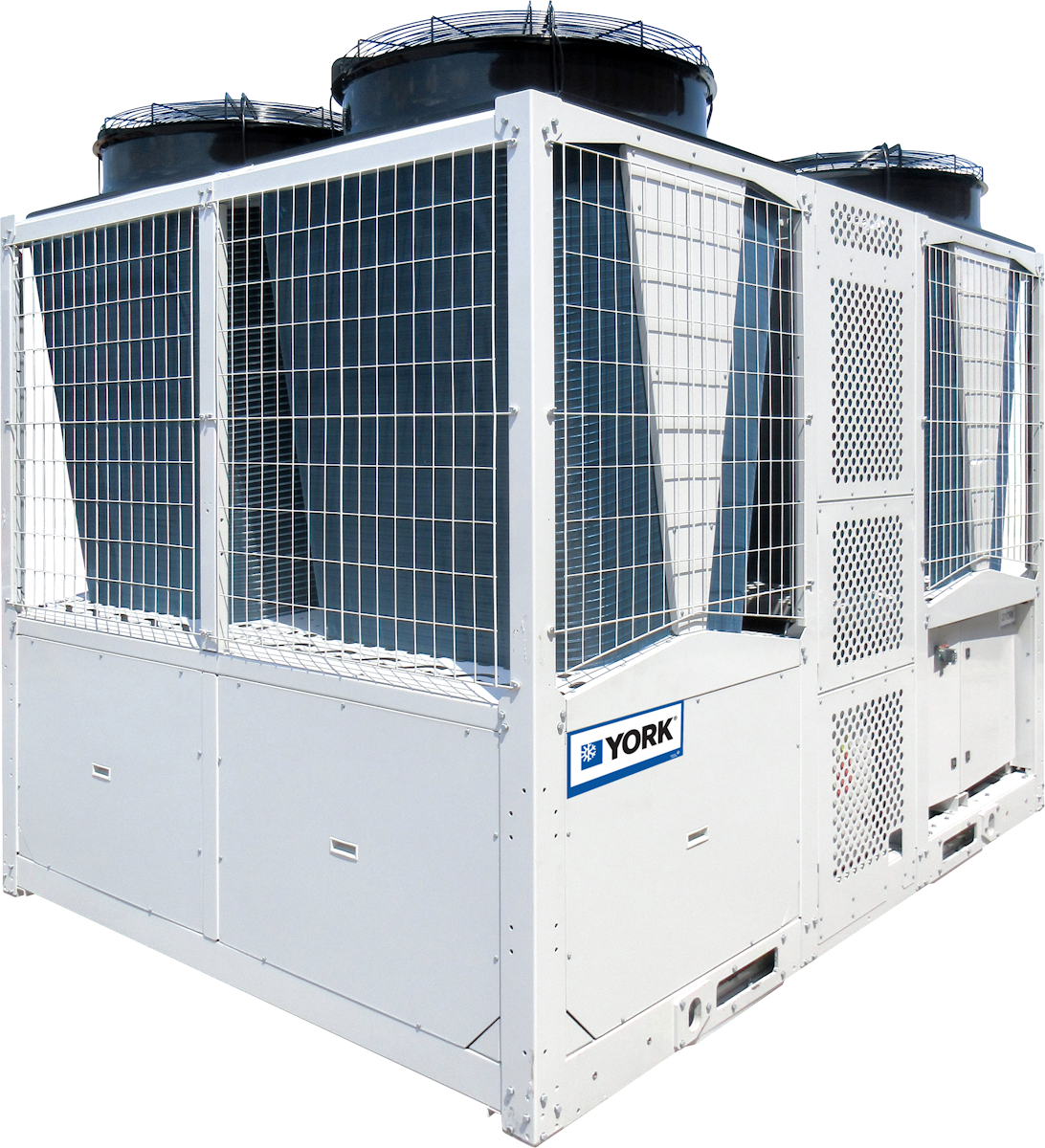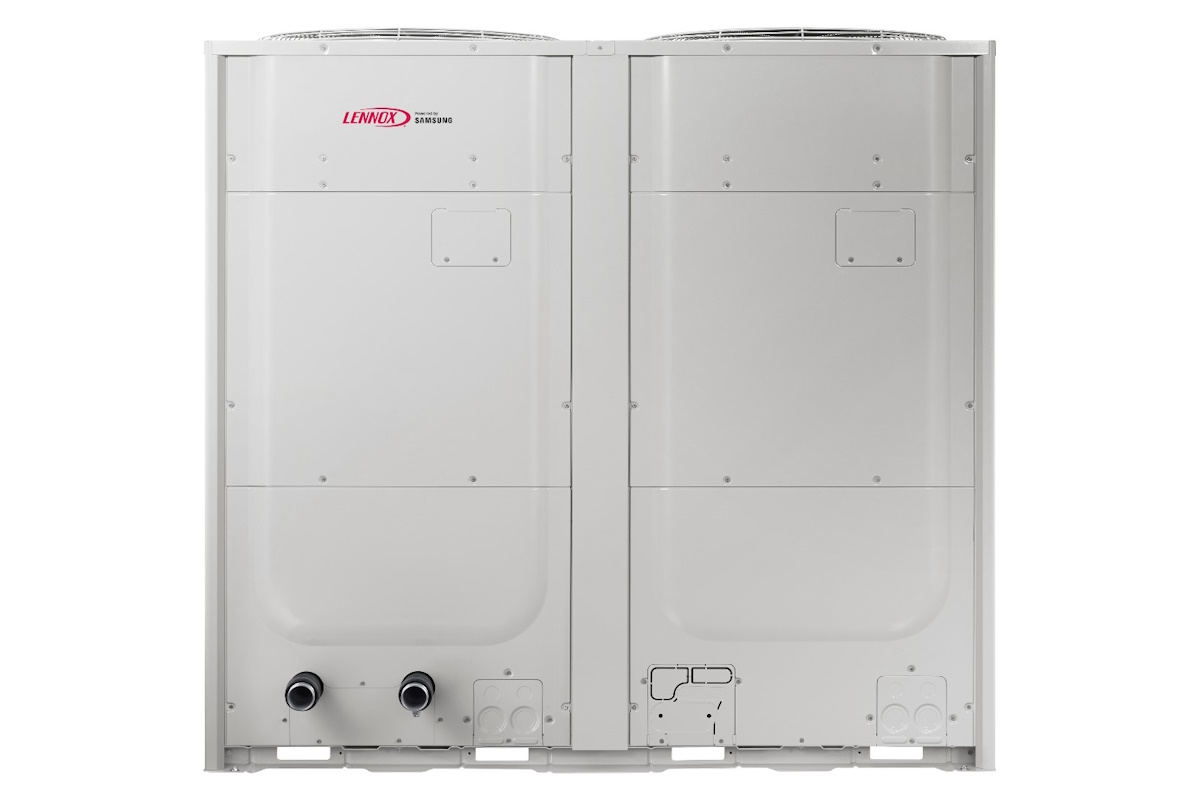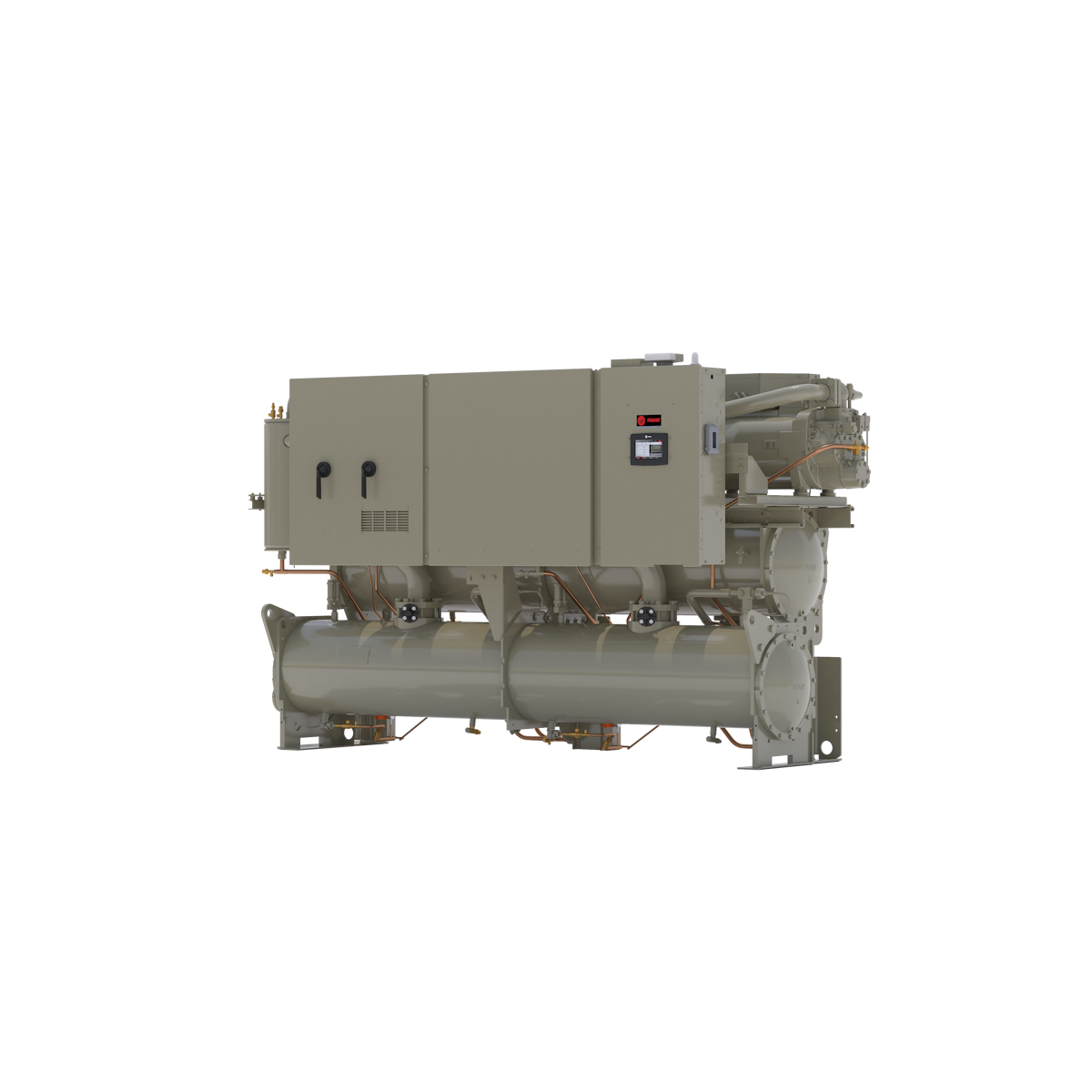Residential heat pump and a/c systems have grabbed the most attention when it comes to the HVAC equipment designed to comply with federal regulations requiring the use of refrigerants with a global warming potential (GWP) of less than 700.
But, the high-capacity chillers used for cooling in commercial and government buildings, schools, hospitals, museums, and other large buildings are subject to the same regulations, which came out of the American Innovation and Manufacturing (AIM) Act of 2020. Chillers that require refrigerant with a GWP of 700 or greater can no longer be manufactured or imported beginning this year, and a new generation of equipment using lower-GWP refrigerants has been launched as a result for equipment replacements and new construction.
Here’s a look at new or re-engineered chillers, all of which use lower-GWP refrigerants, from five major manufacturers.
Johnson Controls
The York YMAE, from Johnson Controls, is a versatile air-to-water heat-pump chiller that can provide heating or cooling only as well as, in a four-pipe version, simultaneous heating and cooling.
The YMAE is based on York’s Amichi platform, but features new hardware, according to Gerald Laumann, global product manager for air-cooled chillers and heat pumps at Johnson Controls. It’s engineered to use R-454B (which has a GWP of 466) and is available in capacities ranging from 35 to 140 tons.
“Featuring variable-speed inverter scroll compressors with enhanced vapor injection (EVI) technology, the York YMAE is engineered to efficiently widen the operating map by providing water temperatures up to 130°F at low-ambient conditions of 0°F,” Laumann said. “Direct-current (DC) inverters provide variable-capacity control and allows the heat-pump compressors to operate more efficiently across all cooling loads compared to constant-speed heat pumps that use a step-unloading design.”

JOHNSON CONTROLS: The York YMAE chiller, from Johnson Controls, can provide heating or cooling and uses R-454B refrigerant. (Courtesy of Johnson Controls)
The YMAE has an IPLV rating of up to 20.1, exceeding the ASHRAE 90.1-2022 standard by 54%, Laumann said.
The YMAE also has high-efficiency, electronically commutated (EC) fans, updated heat exchangers, and a design that enables the surface area for heat transfer to remain active at part load, Laumann said.
“The compact, modular design simplifies installation and can be arranged in varying footprints to meet a wide range of size and application requirements,” he added.
The YMAE has BACnet MS/TP and Modbus RTU or N2 connectivity capabilities for communications with most building management systems.
The YMAE is ideal for schools, multi-unit residential buildings, hotels, and healthcare facilities, Laumann said. It was brought to market in September of 2023.
Lennox
Lennox International Inc. is scheduled to debut the Lennox Powered by Samsung Varix modular heat-pump chiller this spring. The new air-cooled model comes out of a joint venture between Lennox and Samsung Electronics for the sale of ductless and variable-refrigerant flow (VRF) products.
The Varix will be able to provide cooling or heating and will use R-32 refrigerant. It employs VRF technology and inverter scroll compressors and has an EER rating of up to 11.54, a heating COP rating of up to 3.84, and an IPLV rating of up to 21.53, according to company literature.
“Advanced control system provides precise and efficient control of the chiller heat pump system,” said Mimoun Abaraw, director of engineered sales at Lennox. “A wealth of information is provided to system operators. BACnet interface is available to integrate the Varix chiller into the building’s control system, allowing seamless control and status information.”

LENNOX: The Lennox Powered by Samsung Varix modular heat-pump chiller uses R-32 refrigerant is scheduled to debut this spring. (Courtesy of Lennox International Inc.)
The Varix will come in two module capacities, 10 tons and 15 tons, and modules will be able to be combined to provide capacities of up to 240 tons, Mimoun said.
The Varix will be ideal for emergency retrofit replacements, Mimoun said, as well as for schools, multi-family residential buildings, industrial process systems, and data and telecom centers.
The modules are 5 feet, 10 inches long by 2 feet, 7 inches wide, by 5 feet, 6 inches high, Mimoun said, and weigh 1,008 pounds, light enough to fit in most elevators. The modular design allows for system redundancy, and individual modules can be serviced while the others keep running, he added.
Trane Technologies
Trane’s Series R RTWD chillers come in capacities of between 80 tons and 250 tons and were recently re-engineered to use lower-GWP refrigerants.
The Series R RTWD chillers are helical rotary screw-driven, water-cooled heat-pump chillers that can provide both heating and cooling. They use R-513A refrigerant for cooling and R-515B for heating.
“Series R RTWD chillers offer versatility for a variety of commercial applications that require precise temperature control,” said Oakley Roberts, vice president of product management for commercial HVAC in the Americas at Trane Technologies. “As a heat-pump chiller, the RTWD offers flexibility for high-temperature commercial applications and can also work with specialized low-temperature applications.”

TRANE: The Series R RTWD chillers, from Trane Technologies, use R-513A refrigerant for cooling and R-515B for heating. (Courtesy of Trane Technologies)
The RTWD chillers feature Trane’s Symbio 800 Controller for integration with Trane’s Tracer SC+ building automation system, according to Roberts. Their direct-drive compressors have fewer moving parts than other compressors, resulting in increased up time, he said, and the dual-compressor design offers redundancy and thus improves reliability.
Heat recovery, Roberts said, enables the RTWD to recover heat for water heating and allows for tight temperature control that reduces operating costs.
“When coupled with thermal energy storage (TES) tanks, the RTWD chiller can be integrated into a heating and/or cooling thermal management system to help reduce operating costs, lower carbon footprint, and support renewable energy,” Roberts said.
Carrier
Carrier Global Corp.’s Aqua-Edge 19MV water-cooled centrifugal chiller is a completely new chiller engineered for the low-GWP refrigerants R-513A, R-515B, or R1234ze(E).
The AquaEdge was introduced in late 2021 and has seen updates that added to its refrigerant options and cooling capacities, and a smaller model has also been launched since then, a statement from the company said.
The cooling-only chiller is available in capacities ranging from 150 tons to 700 tons. It has a full-load coefficient of performance (COP) of up to 6.8 and a part-load COP of up to 11.3, according to information on the company’s website. The AquaEdge has built-in BACnet compatibility.
The AquaEdge has a compact design that allows it to fit through standard double doors without having to be disassembled.
“The award-winning 19MV was designed to deliver reliable performance, incredible efficiency, easy installation, and a wide operating range,” a statement from the company said. “The chiller combines best-in-segment efficiency for design and the ability to operate at severe conditions due to unexpected building operation or extreme weather.”
In addition to chillers using the refrigerants R-513A, R-515B, R-1233zd(E), and R-1234ze(E), Carrier offers chillers that use R-32. The use of lower-GWP refrigerants, the company said, is moving Carrier toward its goal of helping customers avoid 1 gigaton of greenhouse gas emissions by 2030.
Daikin Applied
The Trailblazer AGZ-F chiller, designed to use the A2L refrigerant R-32, evolved from an earlier model, the Trailblazer AGZ-E, which used R-410A, which is now subject to the phasedown of higher-GWP refrigerants.
R-32 has a GWP of about 677, compared to R-410A’s GWP of 2,088.
The AGZ-F is an air-cooled scroll chiller that’s best suited for comfort cooling and process cooling, according to Alex Albrecht, air-cooled chillers product manager at Daikin Applied. It’s available in capacities of between 30 tons and 240 tons.
“The Trailblazer AGZ-F chiller delivers reductions in spatial footprint, weight, and refrigerant charge, and improvements in integrated part-load value compared to previous models,” Albrecht said. “Trailblazer serves a wide variety of applications — from mission-critical buildings and data centers to hospitals and manufacturing facilities.”
The Trailblazer AGZ-F is a cooling-only chiller with an energy efficiency ratio (EER) rating of up to 11.13 and an integrated part-load value (IPLV) rating of up to 17, Albrecht said. It can be used with either a BACnet or Modbus communications network.
The model was introduced in October of 2023.

